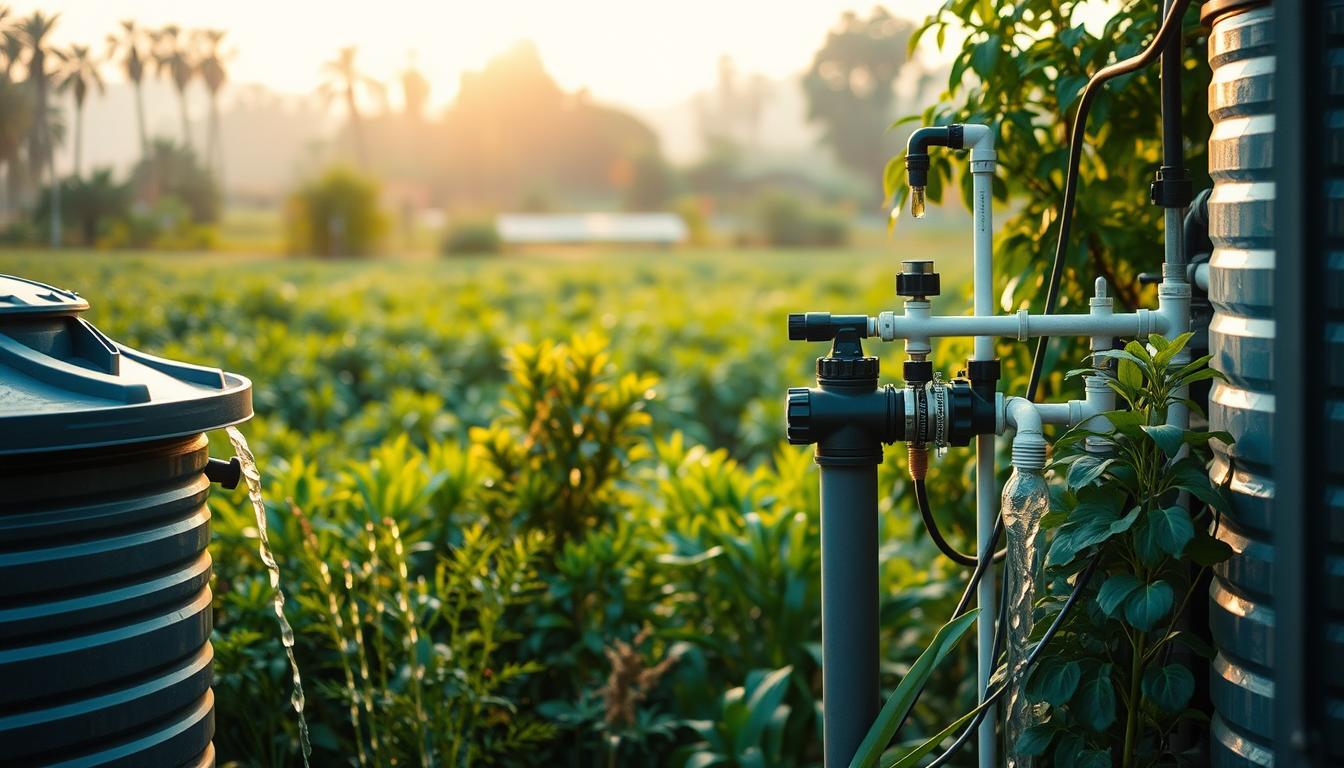Have you ever watched rain pour down your gutters and wondered if that water could serve a better purpose? Collecting rain offers a simple yet powerful way to take control of your water usage. This age-old practice has evolved into a modern solution for both environmental challenges and household budgets.
Water conservation becomes increasingly important as communities face rising utility costs and growing environmental concerns. By capturing what falls freely from the sky, you can significantly reduce your monthly bills while contributing to sustainable water management in your area.
The beauty of this approach lies in its simplicity and accessibility. Whether you live in a sprawling countryside home or a modest urban dwelling, options exist to fit your space and needs. From basic barrel setups to sophisticated collection systems, the initial investment typically pays for itself through reduced water bills.
Beyond the financial benefits, there’s something deeply satisfying about becoming more self-sufficient and environmentally responsible. As we explore the various methods and benefits in the following sections, you’ll discover just how easy it can be to start your journey toward smarter water use.
The Water Crisis and Why Conservation Matters
Reservoirs are shrinking and aquifers are depleting across the United States. Water conservation has become a critical need. What was once seen as an endless resource is now facing its limits, forcing communities to reevaluate their water use.
Climate change, growing populations, and old infrastructure are creating a water crisis. Even places with plenty of rain are now facing dry spells. Arid areas are seeing droughts worsen.
The Reality of Water Scarcity in America
Water scarcity is no longer just a problem in the Southwest. The U.S. Geological Survey says 40 states could face water shortages in the next decade. The Ogallala Aquifer, vital for irrigation, has dropped by over 150 feet in some spots.
California’s drought led to record-low reservoir levels. The Colorado River Basin is experiencing its worst drought in 1,200 years. Even the Great Lakes region is facing shortages due to infrastructure and contamination.
Urban areas are also struggling. Cities like Atlanta, Las Vegas, and Phoenix have water restrictions. They’re trying to meet growing demands with limited supplies. This shows why water conservation is crucial for the nation.
| Region | Primary Water Challenge | Projected Shortage Timeline | Conservation Impact Potential |
|---|---|---|---|
| Southwest | Prolonged drought | Already occurring | High (25-40% reduction possible) |
| Southeast | Population growth | 5-10 years | Medium (15-25% reduction possible) |
| Midwest | Aquifer depletion | 10-20 years | Medium (15-30% reduction possible) |
| Northeast | Aging infrastructure | 15-25 years | Medium (10-20% reduction possible) |
How Individual Actions Create Collective Impact
Individual actions can make a big difference in the water crisis. A single household using rainwater harvesting can save thousands of gallons a year. When many households do this, it greatly reduces the strain on municipal water supplies.
In Tucson, Arizona, rainwater harvesting has captured millions of gallons. This has cut down on municipal water use by nearly 5%. It also helps prevent flash flooding during monsoon seasons.
Even in areas with plenty of water, saving it is still beneficial. Seattle’s water conservation program allowed it to grow by 30% without using more water. This shows how individual choices can help mitigate droughts.
Every gallon we harvest means less water that needs treatment and pumping. By catching rain, we join a movement to protect our water for the future. This helps our communities and preserves water for generations to come.
Understanding Rainwater Harvesting Systems
Rainwater harvesting systems are a mix of basic physics, smart design, and caring for the environment. They collect rain from your roof and turn it into a useful resource for your property. This can help water your garden or cut down on your use of city water. Knowing how these systems work is the first step to using less water.
The Science Behind Collection and Storage
Rainwater harvesting works because of gravity. Rainwater flows from your roof into a storage system. It’s simple, but the best systems have special parts to keep the water clean and efficient.
- Collection surface – Usually your roof, which affects how much and how clean the water is
- Conveyance system – Gutters and downspouts that guide the water
- First-flush diverters – These devices skip the first water, which has more dirt
- Filters and screens – They catch leaves and tiny particles
- Water storage tanks – Made from materials like plastic or concrete, sized for your needs
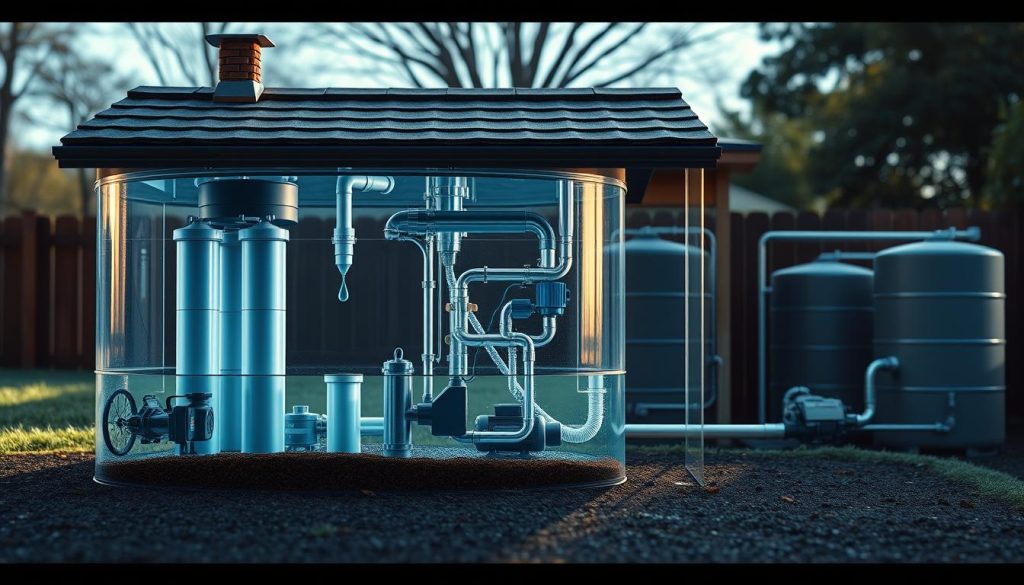
The cleanliness of your rainwater depends on your roof and filters. Most homes use roof water, which needs to be cleaned before it’s stored. Some systems even use UV treatment or extra filters for drinking water.
From Ancient Practice to Modern Necessity
Rainwater harvesting isn’t new. The Mayans used underground cisterns over 2,000 years ago. The Romans built big systems to use rainwater in their cities. They knew rain was valuable.
As cities grew, using rainwater became less common. Many thought it was old-fashioned. But now, with water getting scarcer, people are coming back to it.
Today’s rainwater systems are much better than before. They use new materials and technology. This shows how we’re combining old wisdom with new tech to save water.
This change in using rainwater is big. It shows we’re learning to value water more. As the climate changes and cities grow, using rainwater is key for a green future.
Financial Benefits That Make a Difference
Rainwater harvesting is not just good for the planet. It also saves money, making it a smart choice for homeowners. The savings can be a big reason why families choose to use rainwater. Let’s look at how you can save money by using rainwater.
Calculating Your Potential Water Bill Savings
Start by doing some simple math to see how much you can save. Your savings depend on a few things:
- Roof collection area (square footage)
- Local annual rainfall (inches per year)
- Current municipal water rates
- Water usage patterns
- System efficiency
For example, a 1,500 square foot roof in an area with 30 inches of rain can collect about 28,000 gallons a year. With water costing $0.005 per gallon, you could save $140 a year.
To figure out your savings, multiply your roof size by the rain and system efficiency. Then, multiply that by your water rate. This will give you your yearly savings.
Using rainwater for things like garden irrigation can save even more. It’s a big part of water use in summer.
Long-Term Economic Advantages
Rainwater harvesting saves money not just on your water bill. It’s a smart investment for your home. These systems offer benefits that grow over time.
Water rates have gone up 5.5% a year for the last decade. This trend is likely to continue. Your rainwater system keeps your water costs low, protecting you from future price increases.
Initial Investment vs. Lifetime Returns
The cost of rainwater harvesting systems varies. Simple setups might cost $100-300, while full systems can be $5,000-15,000. But, they pay for themselves in 3-7 years.
After that, you save money every year. A $2,500 system could save $300 a year. Over 25 years, that’s $7,500 saved, a 300% return on investment.
Increasing Property Value
Homes with rainwater harvesting systems are more attractive. Studies show they can sell for 3-7% more than similar homes without them.
This is because of the practical benefits and growing demand for eco-friendly homes. Real estate agents say these systems can sell homes faster, which is great in areas with high water costs.
These systems also give homeowners independence from water service issues. They’re a key part of sustainable water management.
Environmental Impacts Beyond Your Wallet
Installing a rainwater harvesting system does more than save you money. It makes you a key player in protecting the environment. By using rainwater, you help your community and local ecosystems in big ways. As the weather gets wilder and water gets scarcer, these benefits are more important than ever.
Reducing Stormwater Runoff and Erosion
In cities and towns, hard surfaces like roofs and roads stop rainwater from soaking into the ground. Heavy rain turns these surfaces into fast-moving rivers of water. This water picks up pollutants and carries them into our waterways.
This polluted water harms our rivers and streams. It also erodes soil, damages banks, and causes flooding. It’s a big problem for our environment.
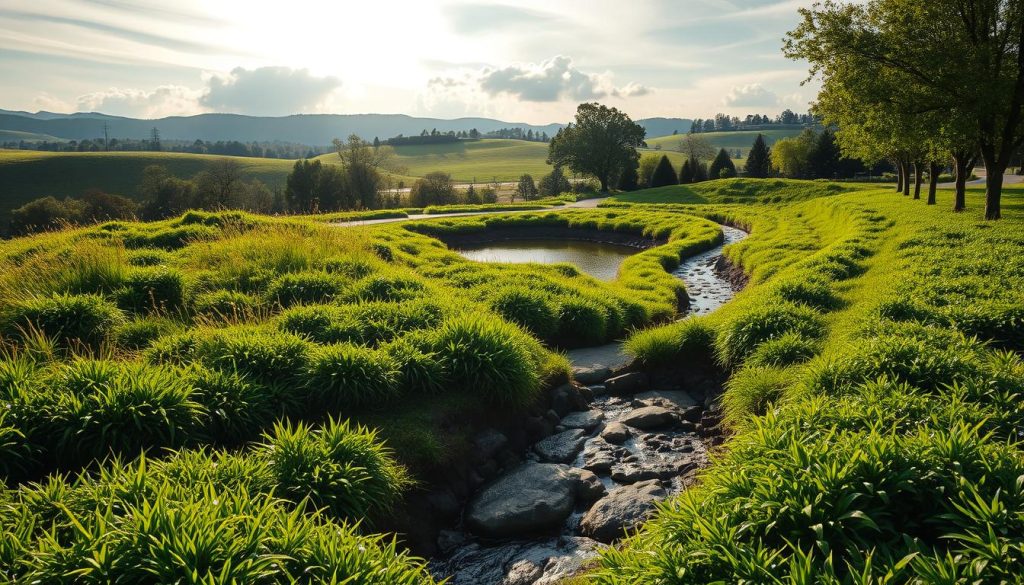
Rainwater harvesting stops this problem at the start. By catching rainwater, you keep it from becoming harmful runoff. Every gallon you collect means less pollution and erosion. A home system can save thousands of gallons a year, making a big difference in neighborhoods.
Decreasing Pressure on Municipal Systems
Municipal water systems use a lot of energy. They pull water from sources, treat it, pump it, and treat it again. This process is bad for the planet.
Harvesting rainwater lowers the demand on these systems. This means less energy for pumping and treating. It also means fewer carbon emissions. For areas with water shortages or old infrastructure, rainwater harvesting can save a lot of money.
It also helps our natural water sources. With less demand, less water is taken from rivers and lakes. This keeps water levels healthy and protects the plants and animals that live there. In places where groundwater is being used up, rainwater harvesting gives aquifers a chance to recharge.
Rainwater Harvesting: From Simple to Sophisticated
Rainwater harvesting is versatile, from simple DIY projects to complex systems. It suits all budgets and conservation goals. Let’s look at the range from easy to advanced setups.
Basic Rain Barrel Systems for Beginners
Starting with water conservation is easy. A basic rain barrel system can be set up in a weekend for under $100. It includes a 50-60 gallon barrel under a downspout to catch roof runoff.
These systems are great for beginners. They have a debris screen, a spigot for water access, and an overflow. Even a basic setup can collect hundreds of gallons, cutting down on outdoor water use.
- Typical components: Food-grade barrel, downspout diverter, spigot, overflow hose
- Average cost: $75-150 for DIY setup
- Collection capacity: 50-100 gallons
- Best uses: Garden watering, plant irrigation
Intermediate Dry Collection Systems
Intermediate systems are for those who want more. They are called “dry” because the pipes empty after each rain. These systems have more storage and better filters.
Intermediate systems use first-flush diverters to keep water clean. They can hold 200-500 gallons, supporting bigger gardens and cleaning needs. Many add soaker hoses or gravity-fed irrigation lines.
These systems cost $300-800, depending on size and quality. They are still DIY-friendly but need some planning and plumbing knowledge.
Advanced Wet Systems with Underground Storage
Advanced “wet” systems are for serious water savers. They have underground cisterns that store thousands of gallons. These systems are nearly invisible but collect a lot of water.
Advanced systems have better filters, strong pumps, and pressurized delivery. They can even supply water for indoor uses like flushing toilets and washing clothes. The underground tanks keep water cool and prevent algae.
These systems cost $2,000-10,000+ but offer the best water harvesting. They save money on water bills and increase property value. Professional installation is recommended, but the benefits are worth it for those who want to be water-independent.
Designing Your Perfect System
Creating a rainwater harvesting system that fits your needs takes careful planning. You need to think about how much water you can collect, how much to store, and how it will work with your property. By planning well, you’ll get the most out of your system with little upkeep.
Assessing Your Needs and Collection Potential
First, decide how you’ll use the rainwater. Do you want it for your garden, washing cars, or household use? Each use needs different amounts of water. For gardens, about 0.5 gallons per square foot per week is needed.
For indoor uses like flushing toilets, you’ll need 20-30 gallons per person daily. Making a water budget helps figure out how much storage you need and how complex your system should be.
Calculating Roof Catchment Area
Your roof is where most of the water will collect. Measure its footprint, not the actual surface area. For pitched roofs, this method is good for estimates. The type of roof affects how much water you can collect.
Estimating Rainfall Collection Volume
To figure out how much water you can collect, use this formula: Catchment area (sq ft) × Rainfall (inches) × 0.623 = Gallons collected. For example, a 1,500 square foot roof with 1 inch of rain can collect about 935 gallons. Check your local weather service for average rainfall to estimate yearly collection.
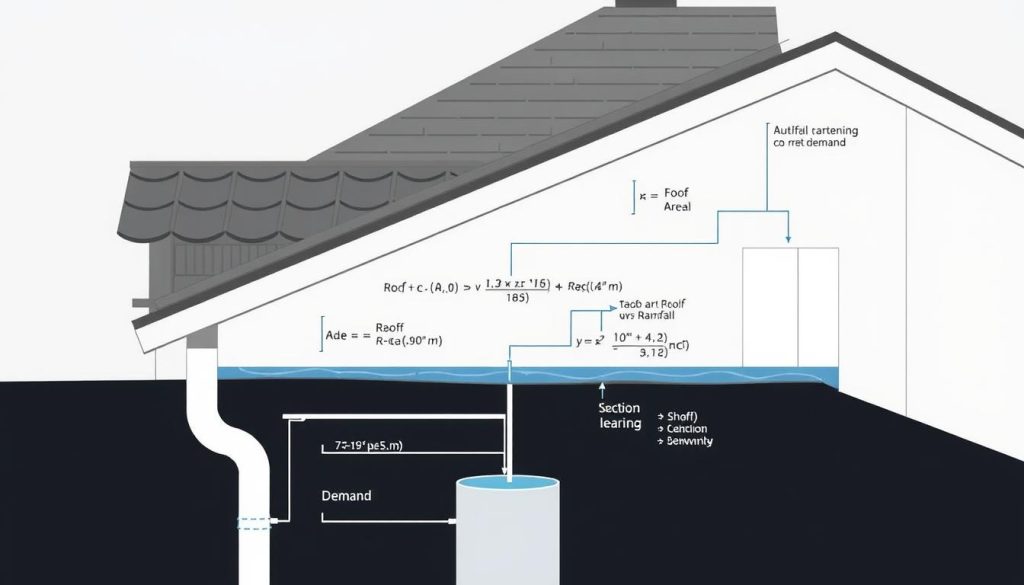
Selecting Quality Components
The quality of your system’s parts is crucial. Start with gutters and downspouts that fit your roof size. For most homes, 5-inch gutters are enough, but steeper roofs or more rain might need bigger sizes.
First-flush diverters are key for clean water. They divert the first water that’s full of dirt. Look for ones with automatic reset, like Rain Harvesting or EarthMinded. For filters, use a multi-stage system with screens, basket filters, and finer filters before storage.
Choose tanks that are UV-resistant for above-ground use or concrete for underground. Bushman and Norwesco offer good options with overflow protection and easy access.
Aesthetic Integration with Your Property
A well-designed rainwater system should look good, not bad. For tanks you can see, pick decorative ones that match your home. Some tanks look like terra cotta urns or stone, adding to your yard’s look.
Place tanks in spots that hide them, like behind plants or in corners. Slim tanks can fit in tight spaces. Paint tanks to match your house or add wooden surrounds for a unified look.
Adding rain gardens can make your system look even better. These planted areas filter water and add beauty to your yard. They use native plants that do well in changing moisture levels.
Installation and Maintenance Realities
The success of your sustainable water system depends on how you install and maintain it. Rainwater harvesting is great, but knowing the setup and upkeep is key. This ensures your system works well for a long time.
DIY Projects vs. Professional Installation
Simple rain barrel systems are great for DIY fans. You’ll need basic tools and a bit of know-how. Most setups take a weekend and cost $100-300.
But, more complex systems need a pro. These include grading, excavation, and electrical work. Costs range from $2,000 to $10,000+ for a full setup. This ensures it’s done right and meets local codes.
Seasonal Maintenance Requirements
In spring, clean gutters and downspouts after winter. Also, check for any pipe damage from freezing. Summer means monthly filter checks to avoid clogs.
Fall is for clearing gutters and getting ready for winter. In cold areas, winterize by draining pipes and storing pumps indoors. Most maintenance takes just 2-4 hours a season.
Troubleshooting Common Problems
Low water collection means clogged gutters or downspouts. Regular cleaning fixes most issues. For ongoing problems, check the system’s slope.
Foul smells or discolored water mean algae or organic matter. A first-flush diverter or UV filter can solve this. Mosquitoes are a concern, but sealed tanks and mosquito dunks help. Pump issues often come from power, debris, or air locks. Try simple fixes before calling a pro.
Navigating Legal Waters and Incentives
Before you start your rainwater collection system, you need to understand the laws and incentives. The rules for rainwater harvesting change a lot across the United States. Some places really support these systems, while others have strict rules. Knowing these differences can save you money and avoid legal problems.
Understanding State-Specific Regulations
Every state has its own rules for rainwater harvesting. These rules can be about water rights, public health, and the environment. For example, Colorado used to have very strict rules, but now they’re more relaxed. Texas, on the other hand, encourages rainwater harvesting as part of its green plans.
You might face different regulations, such as:
- Water rights laws that tell you who can collect rainwater
- Building and plumbing codes that set system standards
- Health department rules about water quality
- Local laws about where and how systems can be placed
- Rules for managing stormwater and recharging groundwater
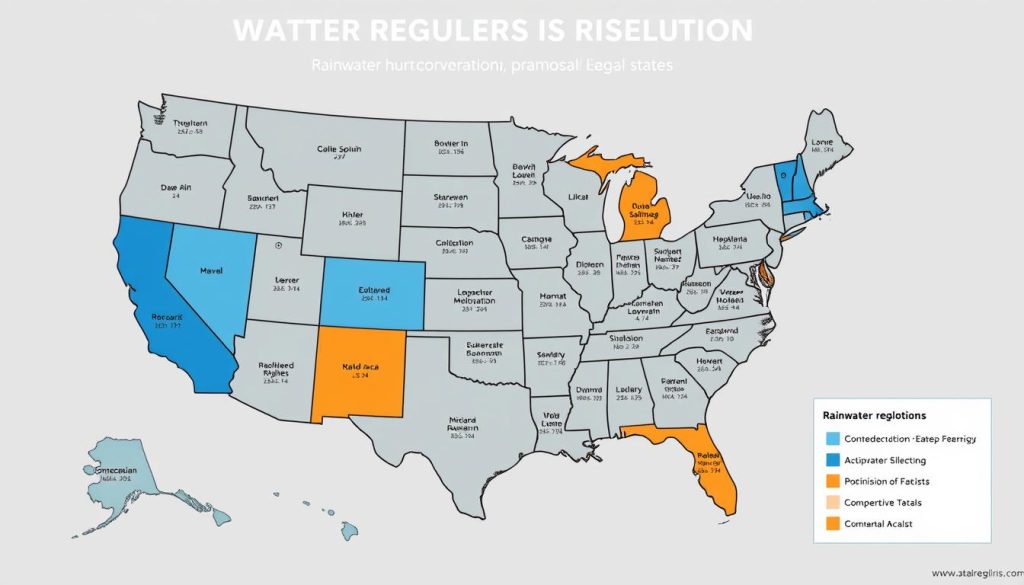
To find out what rules apply to you, contact your local building department or water utility. Many states have websites that explain their policies on rainwater harvesting. As water conservation becomes more important, laws are getting more supportive. But, it’s always wise to check before you start.
Available Rebates, Tax Credits, and Incentives
Installing a rainwater harvesting system can be cheaper thanks to incentives. These programs help because they see the value in saving water and easing pressure on city water systems.
Some common incentives are:
- Municipal rebates to help with costs
- State tax credits for certain equipment
- Lower stormwater fees for properties with systems
- Discounts on water bills for saving water
- Special loans for green projects
In Tucson, Arizona, you can get up to $2,000 back for a complete system. Santa Fe County in New Mexico offers a 25% tax credit for system costs. Cities with stormwater problems often give out big incentives to encourage using rainwater.
To find incentives near you, talk to your local water provider or check your state’s environmental agency website. Use the Database of State Incentives for Renewables & Efficiency (DSIRE) too. Each program has its own rules, like needing to show your system’s details and proof of installation. Many require approval before you start, so plan ahead.
Real-World Success Stories
From city centers to rural areas, rainwater harvesting is making a big impact. It shows how collecting rainwater can solve today’s problems and protect our environment. People are using it to change their communities and homes for the better.
Urban Applications That Inspire
In Seattle, the Bullitt Center is a shining example of urban innovation. It captures 100% of its water from the roof, treating it for all needs. This has cut down on water use by over 565,000 gallons a year.
Chicago’s Green Alley Program is another success. It uses special pavements and gardens in alleys to reduce flooding by 80%. It also helps recharge groundwater.
The Brooklyn Grange, a rooftop farm, captures over 1 million gallons of stormwater each year. This water helps grow food and prevents sewer overflows during heavy rains.
Rural Transformations Worth Noting
In Texas, the Bamberger Ranch Preserve shows how big rainwater harvesting can work. It collects rain from buildings and stores over 100,000 gallons. This helps the ranch survive even in severe droughts.
California farmer Bob Shaffer uses rainwater to cut his irrigation costs by 40%. It also boosts crop yields by 15% during dry times.
In Vermont, Maple Wind Farm collects rainwater from barn roofs for their animals. They gather about 30,000 gallons a year. This helps during dry farming seasons and reduces well use.
These stories show that rainwater harvesting works everywhere. It’s all about designing a system that fits the place. Whether in cities or countryside, it brings big benefits and helps the environment.
Your Journey to Water Independence Starts Now
Starting with rainwater harvesting is easy. Begin with a single rain barrel and a downspout. Even a light shower can fill it quickly.
Here’s how to start your journey:
1. Measure your roof’s collection area (length × width)
2. Check local regulations about stormwater collection
3. Visit hardware stores to explore available components
4. Start a rainfall journal to track potential collection volumes
5. Connect with neighbors who have existing systems
Many people worry about complex setups or high costs. But, starting small is a great way to begin. It lets you learn and save on water bills right away.
Every gallon you collect helps the environment. It reduces erosion, flooding, and pollution. Your efforts join thousands of others in making a difference.
Imagine a future where rainwater harvesting is as common as recycling. Communities could thrive, even in droughts. Water bills would drop, and gardens would flourish. This future is starting in homes like yours.
Your journey to water independence begins with a single raindrop. Catch it today.

